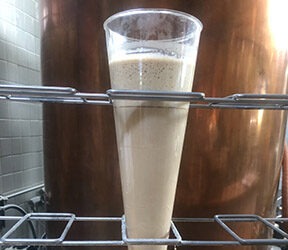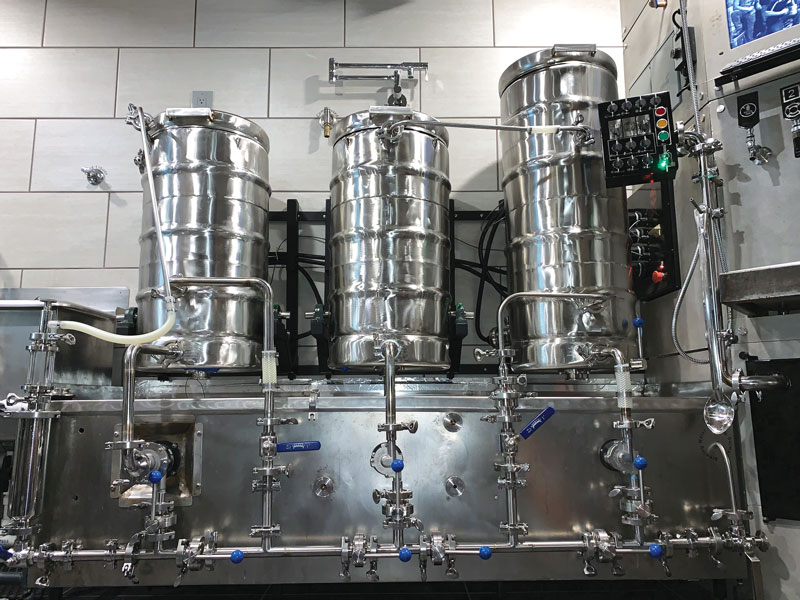Mobile Canning Lines
There was a time when just the thought of drinking canned beer was enough to make one cringe. That philosophy has changed in the last 10 years as craft breweries are embracing the reality that canned beer is better.
There are multiple reasons for this canned beer growth. First, unlike not so long ago, aluminum cans are now lined with a special coating that keeps the beverage from touching the metal. No contact means no strange flavors. Second, it has been scientifically proven that beer in cans remains fresher longer. With no exposure to sunlight and less oxidization from leaking bottle caps and “head space” (that little pocket of air at the top of each bottle), canned beer remains at its peak flavor, and it will last longer on the shelf. Third, discerning beer drinkers, simply put, want to drink better beer.
Growing Trend
Mobile canners now operate in the United States, with locations in Colorado, California, Washington, Oregon, Pennsylvania, Michigan, New Mexico, Georgia, Ohio, Virginia and Texas, to name a few. These canners typically work with smaller breweries that can’t afford a full-scale canning unit, or don’t produce quite enough beer to justify the cost — anywhere from $120,000 to $500,000 for the canning machine, plus the often necessary stockpile of pre-printed cans running approximately $30,000 per truck load (about 210,000 cans). Add storage space and costs and, well, mobile canning makes good economic sense for a lot of reasons.
While most canners prefer clients wanting to can 50, 100 or more barrels in a single session, some will venture forth into the homebrew community to can beer at special events. In Washington, Northwest Canning has canned for homebrewers on multiple occasions, including at a Wingman Brewery event. Colorado’s Mobile Canning Solutions has parked at Oskar Blues (instigators of the canned beer revolution with Dale’s Pale Ale) once a year to do likewise.
We Can Mobile Canning, from Danville, Pennsylvania, develops canning equipment to complement their mobile canning operation, has done similarly, including filling hundreds of 12-ounce cans with homebrew at two National Homebrew Day events hosted by Keystone Homebrew Supply in Montgomeryville, Pennsylvania. The team filled everything from beer, cider, wine and mixed cocktails to something called “Jungle Juice.”
“I’m not exactly sure what that was,” We Can founder and “Head Six Packer” Pete Rickert, Jr. says with a light laugh. “I guess it’s pretty potent stuff.”
Rickert has been canning beer (mostly) since 2012, and — like many of his compatriot canners scattered around the country — primarily helps smaller, independent breweries get their product on the shelf. This is a growing trend in the industry and, coupled with the fact that 413 breweries currently can (with more making the switch almost daily), it makes sense that homebrewers should want to follow their favorite brews down the canning path.
“These guys who brew beer at home, they think, ‘I can put my beer in a can, that’s awesome,’” Rickert says. “Most of the (commercial) brewers we work with started as homebrewers. So being part of that homebrew community makes good sense. We’re not there to make money; we’re there to build relationships.”
Bring in the Cans
Brewers looking to can their beer need to do a little legwork before they call a mobile canning company. While the increase in mobile canning operations makes the odds of canning homebrew more likely, an organized event makes the most sense for everyone. The first thing to do is find a local brewer supply shop, or brewery that cans beer, and see if those establishments would be willing to host a mobile canner for a day. A larger homebrew club might also be able to organize an “in-house” canning event (though inviting the public could generate new members too).
The key to homebrew canning success, and the chance to repeat the event, is that no matter who does the organizing, it’s important to ensure that enough homebrewers show up with beer ready to can so that it’s worthwhile for the mobile canner to make the trip — and consider coming back. Most companies I spoke to for this story agree that a minimum of 25 5-gallon (19-L) batches makes a canning event worthwhile.
Typically, mobile canners charge $25-40 for a 5-gallon (19-L) batch, with volume discounts for larger batches. This includes the plain silver cans, and in some cases six-pack holders. Most canners prefer 16-ounce cans for ease of filling, though 12-ounce cans can be used too.
Canning Prep 101
Unlike the straight-forward and well-engrained approach to home bottling, the preparation for canning beer requires some extra work — not much — but it varies depending on the canner’s preferences. That said, it’s best to check well in advance with the canner or event organizer and prepare accordingly. Some mobile canners prefer the beer be primed and uncarbonated, the same as when preparing to bottle at home, while others want beer that’s kegged in Corny or Sanky kegs and carbonated. For the latter option, it’s essential the beer hovers at near freezing for easier and more efficient canning.
“It’s got to be cold. Forty degrees is not cold; 35 degrees or colder is cold,” Rickert says emphatically. “The warmer the beer the higher the carbonation level and the more foam you’re going to create. We’ve run into that problem — a lot of beers that were way over carbonated and not cold enough.” This combination results in low fills from excessive foam, high beer loss and poor quality. Most fillers work better after the machine is cooled by cold beer and this takes time. Usually the first few cases run less than smooth. The losses at start-up can be high enough that the yield would have to be much lower than hand filling. Oskar Blues has a device used to help with this that they have named the Crowler, which is a one-head can filler.
To ensure ease of canning, Rickert recommends brewers try and get the beer on location and into a cooler at least a couple of days ahead of time so it can properly chill and settle out before the canning starts.
“It doesn’t really work very well when a guy’s been driving from two hours away with a keg bouncing around in the back (even if it’s been on ice),” Rickert adds.
Pat Hartman, Mobile Canning Systems Co-Founder, doesn’t believe in this cold and carbonated practice and is in the minority of canners interviewed for this article. The warmer a keg is, the foamier it will be, and canning foam just doesn’t translate into efficient use of beer or equipment. Hartman explains that when brewers show up with finished, warm beer that has been primed as if for bottling there is less chance of dealing with turbulent beer and, perhaps more importantly, less beer loss in the canning process.
“You can’t regulate the temperature very well (for kegged beer),” Hartman says. “If you have warm beer you have more foam because the gas wants to escape. We don’t (can carbonated beer) because we’re only doing five gallons. You’ll waste one or two beers, and that’s adds up for a homebrewer.”
To be clear, if a brewer is unable to keg and carbonate their beer, all the mobile canning operators say they will still can the beer. Doing it Hartman’s way allows the brew some time for can-aging, much as homebrew would bottle-age in glass containers. Note, however, that canning flat beer can result in high air pick-up (just like bottling) since low dissolved oxygen (DO) is only achieved when the lid is placed on foam — fresh, viable yeast is as key to can-conditioning as with bottle-conditioning.
“Do a (run) of tall boys, take it home and let it do its thing,” Hartman says. “It’s just like bottles or anything else you condition.” The main difference in the final product is that the carbonated beer is ready to drink immediately while the aging beers typically takes several weeks or more depending on style.
Shelf life can vary in both processes. For example, New Belgium experienced stability issues when they were canning with a $300,000 small canner and had to begin can-conditioning to combat the problem; Fat Tire in the bottle had better stability and it had not been bottle-conditioned. (They now operate a high-speed KHS can filler and may no longer be can-conditioning). Small-scale can fillers do not operate like high speed machines (600+ cpm) and oxygen pick-up is often much higher than brewers expect. This is why many craft beers in cans contain yeast. If carbonated beer does not FOB (foam on beer) properly during filling high air pick-up should be expected, and if the beer is very bright with little yeast, oxidation should be expected. Can-aged beer does compare well to bottles, however. It does run a small risk of exploding (which would be most likely a can seam rupturing), though, just like over carbonated bottles.
“As far as I know there have been no cans to explode. I ask people to let me know, but no one’s said anything,” said Rickert. He adds (with a laugh) that if you can this way and a homebrew gushes in your face, don’t hold him responsible.
Hartman confirms cans are more resilient than bottles and the aluminum can “stretch” a long way before being compromised. Like Rickert, he’s not heard of any beers exploding. Just be aware of the
risk just as you would for bottling, and remember to be careful not to overcarbonate your homebrew.
Novel Approach
For now, the idea of canning homebrew remains a novelty — something different for the homebrewer to try — but also pretty cool too. The upsides, besides the locked-in freshness, include the fact the beer can more easily be shipped to friends, taken on adventures in the great outdoors (cans are lighter to pack for camping than bottles) and are safer for outdoor festivals and concerts or drinking poolside where glass bottles are forbidden. Add to that the increasing number of craft breweries using cans, and these are just a few reasons why the home canning trend can only expand. Justin Brandt, owner of Northwest Canning has seen such a great response at canning events conducted at brew shops and breweries that he’s actively looking for a Portland, Oregon storefront that will specialize in canning homebrew.
“It’s more about the opportunity,” Brandt says. “We obviously make a living canning for commercial brewers, so it doesn’t make much sense for us to can homebrew. That being said, we do it because we want to support the homebrewer. There’s a market for canning homebrewer’s beer. It’s not huge, but it’s there.”





